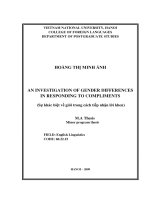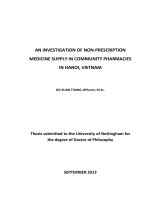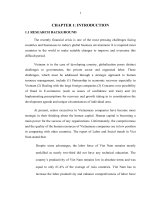An investigation of gender differences in responding to compliments
Bạn đang xem bản rút gọn của tài liệu. Xem và tải ngay bản đầy đủ của tài liệu tại đây (342.42 KB, 8 trang )
An investigation of gender differences in
responding to compliments
Hoàng Thị Minh Ánh
Trường Đại học KHXH&NV
Luận văn ThS. Chuyên ngành: English Linguistics; Mã số: 60 22 15
Người hướng dẫn: DR. Hà Cẩm Tâm
Năm bảo vệ:2009
Abstract: Compliments are very common in English contexts, which are served to increase or
consolidate the solidarity between the speaker and addressee (Holmes,1988).This paper
examines the differences between women’s and men’s compliment responding, exploring the
function of the positive speech acts on the one hand as positive strategies and on the other as
potentially face threatening or saving acts. The data quantified and analyzed in the research were
collected through DCT questionnaires data of 5 females and 5 males. The paper provides an
analysis concerning compliment responses between the same genders and the different genders.
The statistical results show that, generally speaking, there exist significant differences between
men and women when they respond to compliments from others. As for compliment response
strategies between men and women, women tend to apply more agreement than men, while men
use more non-agreement than women. Therefore, our former hypothesis can be true that there do
exist significant relationship between gender and the realization patterns of this speech act.
Keywords: Tiếng Anh; Giao tiếp; Giới tính.
Content:
vi
Table of contents
Certificate of originality of thesis …………………………………
Acknowledgements…………………………………………………………
Abstract…………………………………………………………………………….
List of Tables …………………………………………………………………….
List of abbreviations and conventions………………………………
Part 1: Introduction………………………………………………………….
1. Rationale………………………………………………………………………
2. Aims of the study……………………………………………………………
3. Scope of the study……………………………………………………………
4. Method of the study…………………………………………………………
5. Organization of the study…………………………………………………….
Part 2: Development…………………………………………………………
Chapter 1: Literature Review…………………………………………
1.1 Overview of speech acts……………………………………………………………
1.2 Compliment and compliment responses………………………………………….
1.2.1 Complimenting as a speech act……………………………………………
1.2.2 Function of compliment……………………………………………………
1.2.3 Compliment responses………………………………………………………
1.3 Politeness …………………………………………………………………………
1.3.1 Definition of politeness………………………………………………………
1.3.2 The face-saving view of politeness………………………………………….
1.3.3 Politeness in complimenting and responding to compliments……………….
1.3.4 Gender and politeness………………………………………………………
1.4 Previous studies of gender in compliment and compliment responses…………
i
ii
ii
iv
v
1
1
2
2
3
3
4
4
4
6
6
8
9
11
11
12
14
15
17
vii
Chapter 2: The study…………………………………………………………
2.1 The research designing…………………………………………………………….
2.1.1 The research question………………………………………………………
2.1.2 Selection of informants………………………………………………………
2.1.3 Data collection instruments…………………………………………………
2.1.4 Situation design………………………………………………………………
2.1.5 Data-collecting procedures…………………………………………………
2.2 Analytical Framework……………………………………………………………
Chapter 3: Data analysis and discussion………………………….
3.1. Data analysis procedures……………………………………………………….
3.2 Results……………………………………………………………………………
3.2.1 Compliment response strategies by males of the topic dimension………….
3.2.2 Compliment response strategies by females of the topic dimension………
3.2.3 Compliment response strategies by gender …………………………………
3.2.4 Summary……………………………………………………………………
3.3 Discussions………………………………………………………………………….
Part 3: Conclusion……………………………………………………………
1. Major findings…………………………………………………………………
2. Implications………………………………………………………………………
3. Suggestions for further research………………………………………………
References……………………………………………………………………
Appendix …………………………………………………………………………
19
19
19
19
19
20
21
22
25
25
26
26
27
28
30
31
36
36
37
38
40
I
1
Part 1: Introduction
1. Rationale
In everyday life, there are a number of speech acts we can choose to show positive
politeness, for example, greetings, hanks, friendly address terms and expressions of
concern. “A compliment is one of them, which notice and attend the hearer’s interests,
wants, needs, goods ” (Holmes: 1988)
Since 1970s, linguists have attached the study of speech act, such as Apology,
Request, Compliment & Compliment Response, Refusal and Complaint, etc. These studies
show that, the social and situational factors, which will exert their influences on the use of
the speech acts, include gender, age, level of education, social distance, social relationship,
style, and ethnicity and so on. Compliments, as a positive speech act, will be inevitably
influenced by these social factors.
Although pragmatists and sociolinguists have examined the relationship between
gender and language for the last thirty years, there is little consensus about this
relationship. As far as female speech is concerned, arguments continue to focus on whether
or not female speakers express powerlessness in their speech or whether they express a
form of speech only different from that of males by using, for example, more polite speech
style. Of the social causes of gender differentiation in speech style, one of the most critical
appears to be the level of education. In all studies, it has been shown that the greater the
disparities between educational opportunities for boys and girls, the greater the differences
between male and female speech (Spolsky, 2000). The more recent feminist theory has
focused on the social construction of gender, not exclusively in childhood but for a whole
lifetime, and this seems to be more powerful in explaining gender differences in language
use.
Compliments are positive speech acts, which are sensitive to both social constraints
and individual variables. Social factors such as age, gender, ethnicity, level of education,
social status and social relationship between the interlocutors will inevitably influence the
complimenting behavior of all interlocutors.
2
Several studies have shown that there are some differences between males and females in
their realization patterns of compliments and compliment responses. Two important studies
that focus on gender differences in complimenting and responding to compliments are
those by Holmes (1988) and Herbert (1990). They found that the syntactic patterns and
lexical choice used by men and women were different. Based on the findings, they
assumed that females use compliments for keeping solidarity while males regard
compliments as potential face threatening acts (FTAs). They examined kinds of topics and
situations, as well as gender-based distributions.
Although a lot of research has been carried out on compliments and compliment
responses, the study on relationship between genders in compliment responses is still
something new in Vietnam. The purpose of this study is to examine the sociolinguistic
characteristics of gender differences in compliment responses, in other words, whether the
social variables of the interlocutors, namely, social status, gender and age, have any
influence on the compliment response strategies the respondent may employ.
2. Aims of the study
This study examines the differences of linguistic strategies between British women’s
and men’s compliment responding, exploring the function of the positive speech acts as
positive strategies. The study provides an analysis concerning the differences between the
same genders and the different genders in compliment responds strategies. The reason why
men and women differ in language use is that they often different role in society.
3. Scope of the study
The study focuses on the differences of linguistic strategies between British male and
female subjects in the workplace in responding to compliments in some daily situations in
terms of linguistic strategies. The data we can obtain from the Discourse Completion Tests
will show us only nonverbal.
Gender is the main variable in the present study. There are four types of compliment
situations with regard to the gender of complimenters and respondents: male – male, male-
female, and female - male, female - female. In each of the situations designed in the
questionnaires, there are two possibilities of the gender group. That is to say, the two
3
interlocutors in each situation might be of the same gender or might be of different
genders. This may influence the production or selection of compliment response strategies.
The study is based on the analytical framework established by Herbert (1986), but
modified by the author for the present study.
4. Method of the study
This study focuses mainly on analysis of the data collected from the survey
questionnaire. The questionnaire is designed to elicit the informants’ compliment
responses in the situations under study. The data collection of this research is done by
using the Discourse Completion Tests (DCTs). It is believed that DCTs constitute
important starting points for further research since they facilitate the collection of large
amount of data. Each discourse sequence presented a detailed description of the situation,
specifying the gender and social status of the complimenter. The participants’ task was
supply the responses to the situation given. The data we can obtain from the DCTs will
show us only “discourse in written form”.
5. Organization of the study
This research includes three parts. Part 1 introduces the rationale, the aims, the scope
and the method of the study. Part 2 is the development of the study. There are four
Chapters in this part. Chapter one will review briefly the related theories, such as speech
acts, politeness, review of the studies on compliments and compliment responses. Chapter
two discusses the methodology of the study, which includes the research questions, design
of the study, the selection of subjects, instruments, situation design, analytical framework
and the procedures of data collecting and analyzing. In Chapter Three, this paper will show
the results of the study. In Chapter Four, this paper will give discussions and the major
findings of the results obtained in the research. And finally in Part 3, this paper will briefly
summarize the major discoveries of this study, indicate the limitations and implications of
the study and point out the directions for further research.
40
References
1. Austin, J. L. (1962), How to do things with words, New York: Oxford University
Press.
2. Brown, P and Levinson, S (1978), `Universals in language usage: politeness
phenomena’, pp.56-311, in ed. Goody, (ed), Questions and Politeness:
Strategies in Social Interaction, Cambridge, Cambridge University Press.
3. Cordella, M., H. Large and V. Pardo. (1995), Complimenting behavior in
Australian English and Spanish speech, Multilingua, pp. 14.3: 235-252.
4. Herbert, R.K. (1986a), Say “Thank you’’- or something. American Speech, pp. 76-
88.
5. Herbert, R.K. (1988a), Compliments and compliment responses in New Zealand,
Anthropological linguistics, pp. 485-508.
6. Herbert, R. K. (1989), The ethnography of English compliments and compliment
responses: A contrastive sketch. In W. Oleksy, (Ed.), Contrastive pragmatics,
Philadelphia: John Benjamins.
7. Herbert, R.K. (1990), Sex-based differences in compliment behavior: Language in
Society, pp. 19: 201-224.
8. Holmes, J. (1986), Compliments and compliment responses in New Zealand
English, Anthropological Linguistics.
9. Holmes, J. (1988a), Compliments and Compliment Responses in New Zealand
English, Anthropological Linguistics, Vol.28, pp. 485-508
10. Holmes, J. (1988b), Paying compliments: a sex-preferential politeness strategy,
Journal of pragmatics (12), pp. 445-465
11. Holmes, J. (1995), Women, Men and Politeness, London, Longman.
12. Lakoff, R. (1975), Language and women’s place, London: Harper and Row
13. Johnson, D. M. and Roen, D. H. (1992), Complimenting an involvement in peer
reviews: gender variation, Language in Society, pp 21.1: 27-57.
14. Leech, G. (1983), Principles of Pragmatics, Longman; London and New York.
41
15. Manes, J. And Wolfson, N. (1981), The Compliment formula, In F. Coumas (ed),
Conversational Routine: Explorations in Standardized Communication
Situations and Prepatterned Speech. The Hague: Mouton Publishers, Pp. 115-
132.
16. Manes, J. (1983), ‘Compliments: A mirror of cultural value’. In N. Wolfson and
E. Judd (eds), Sociolinguistics and language acquisition. Rowley, MA:
Newsbury House, pp. 96-102.
17. Pomerantz A. (1978), Compliment Responses: Notes on the Co-operation of
Multiple Constraints. In J. Schenkein (ed.) 1978. Studies in the Organization of
Conversational Interaction. New York: Academic Press, pp 79-112
18. Pridam F. (2001), The Language of Conversation, London: Routledge, pp. 52
19. Searle, J.R. (1969), Speech Acts. Cambridge University Press.
20. Searle, J. (1979), Expression and meaning, Cambridge: Cambridge University
Press.
21. Spolsky, B. (2000), Sociolinguistics, Oxford University Press.
22. Wan-juan Yu. (2007). Pedagogical Description of Compliment-Response
Exchanges in a British Context for Chinese EFL Learners. MSc in Language
Teaching The University of Edinburgh.
23. Wolfson, N. (1983a), An empirically based analysis of compliments in American
English. In N. Wolfson, & E. Judd, (Eds.), Sociolinguistics and language
acquisition. Rowley, MA: Newbury House.
24. Wolfson N.(1984), Pretty is as pretty does: A speech act view of sex roles,
Applied Linguistics, Vol.5, No.3
25. Ye, L. (1995), Complimenting in mandarin Chinese. Kasper, G. (ed). Pragmatics
of Chinese as Native and Target Language. University of Hawaii, USA.
26. Yule, G. (1996), Pragmatics, Oxford University Press.









